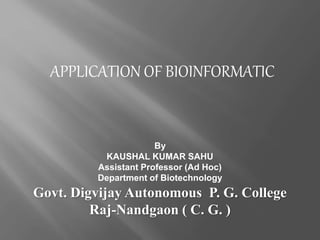
Bioinformatics, application by kk sahu sir
- 1. APPLICATION OF BIOINFORMATIC By KAUSHAL KUMAR SAHU Assistant Professor (Ad Hoc) Department of Biotechnology Govt. Digvijay Autonomous P. G. College Raj-Nandgaon ( C. G. )
- 2. INTRODUCTION HISTORY WHAT IS BIOINFORMATICS APPLICATIONS DNA AND RNA LEVELS CONCLUSION REFRENCES
- 3. "Bioinformatics" to refer to the study of information processes in biotic systems. This definition placed bioinformatics as a field parallel to biophysics or biochemistry (biochemistry is the study of chemical processes in biological systems). the field of bioinformatics has evolved such that the most pressing task now involves the analysis and interpretation of various types of data. This includes nucleotide and amino acid sequences, protein domains, and protein structures.
- 4. Bioinformatics is a newly emerged scientific discipline for the computational analysis and the storage of biological data . Bioinformatics deals with algorithms, databases and information systems, web technologies, artificial intelligence and soft computing, information and computation theory, software engineering, data mining, image processing, modeling , discrete mathematics, , and statistics.
- 5. It was Paulien Hogeweg who invented the term Bioinformatics in 1979 to study the processes of information technology into biological systems. 1969- ARPANET was created by linking computers 1972- 1st recombinant DNA was created by paulberg 1988- NCBI is established 1991- creation of protocol which make up WWW 1955- Haemoplilus influenzae genome seq. crested 2001- human genome project is published.
- 6. SEQUENCE ANALYSIS The application of sequence analysis determines those genes which encode regulatory sequences or peptides by using the information of sequencing. For sequence analysis, there are many powerful tools and computers which perform the duty of analyzing the genome of various organisms.
- 7. It is easy to determine the primary structure of proteins in the form of amino acids which are present on the DNA molecule but it is difficult to determine the secondary, tertiary or quaternary structures of proteins. For this tools of bioinformatics can also be used to determine the complex protein structures.
- 8. In genome annotation, genomes are marked to know the regulatory sequences and protein coding. Comparative genomics is the branch of bioinformatics which determines the genomic structure and function relation between different biological species. For this purpose, intergenomic maps are constructed which enable the scientists to trace the processes of evolution that occur in genomes of different species.
- 9. Historically, drugs were discovered through identifying the active ingredient from traditional remedies or by serendipitous discovery. Later chemical libraries of synthetic small molecules, natural products or extracts were screened in intact cells or whole organisms to identify substances that have a desirable therapeutic effect in a process known as classical pharmacology.
- 10. Rapid sequencing of other organisms: Comparative whole genome analysis can provide clues about molecular evolution. While a conserved sequence provides information about motifs; the sequence differences provide information about diversity of form and function.
- 11. The problem with given DNA sequence fragments of 200-700 base pairs length from a sequence project, the objectives is to assemble them into the original DNA sequences from which the fragments are derived. one has to determine how similar the two sequences are and show where the two sequences match.
- 12. Repetitive sequences in DNA: In a DNA domain, a motivation for multiple sequence alignment arises in the study of repetitive sequences. These are the sequences of DNA, often without clearly understood biological functions, that are repeated many times throughout the genome. The repetitions are generally no exact, but differ from each other in a small number of insertion, deletion, duplications and substitution.
- 13. Simultaneous monitoring of expression of all genes:- mRNA levels define state of the cell. The approach is to monitor all mRNA at quantitative level of 1 molecule per cell and a qualitative sensitivity level sufficient to distinguish alternative splicing. Use of DNA microarrays can help in this. This information can be used for: DESCIPTION CLASSIFICATION CIRCUITRY
- 14. MONITORING LEVEL AND MODIFICATION STATE OF ALL PROTEINS It is important to monitor post translational proteins and genetic networks modification, e.g. phosphorylation state. It is possible to do a 2D protein gel analysis of protein, followed by mass spectroscopy analysis.
- 15. Most probably, there are limited no. Of proteins shapes and hence a limited no. of proteins families. One can analyse amino acid sequences against database of protein shapes. Some of the bioinformatics databases are being used :- Pfam- protein multiple sequence alignment and common protein domains. SCOP- Structural classification of proteins. CATH- Protein classification by class, architecture, topology, and Homology.
- 16. A protein family is a collection of proteins with similar structure, similar function, or similar evolutionary history. When we have a newly sequenced protein, we would like to know to which family it belongs, as this provides hypothesis about its structure, function, or evolutionary history.
- 17. Find genes in a genome Predict the gene product Predict the gene function
- 18. So, we can conclude that bioinformatics has emerged as a very promising and important discipline for academics, research, and industrial application for the data storage, data warehousing and analysing the sequences etc., which has influenced scientific, engineering and economic development of the world.
- 19. So, we can conclude that bioinformatics has emerged as a very promising and important discipline for academics, research, and industrial application for the data storage, data warehousing and analysing the sequences etc., which has influenced scientific, engineering and economic development of the world.
- 20. Bioinformatics- concept skills and application by S.C. Rastogi , Namita Mendiratta, Parag Rastogi U. satyanarayan(2005) en.wikipedia.org/wiki/bioinformatics
